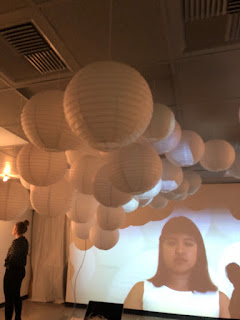Week 7
We evaluated two different takes on the overlap between neuroscience and art: neurochemical reactions (such as using drugs to stimulate the brain and the brain serving as inspiration and art itself.
Drugs were often used to stimulate the brain. Timothy Leary, a Harvard professor that was a strong supporter of LSD, spread the drug to the college campus where people began to take it recreationally. In a sense, the neurochemical reactions taking place in user's brains were art. This idea is also shown in Damein Hirst's work, Lullaby Spring, where pills are displayed as "delicate pieces of scientific craft." (Hirst) I also interpreted this piece of work as the pills, that can make us hallucinate and have wild dreams, as the art themselves.
The brain serving as inspiration or art itself is displayed in the work of Jonathon Keats, when auctioned off his brain as a sculpture. Keats work intrigued me as it pushed the idea of what art can be to a whole new level. Similarly, Suzanne Anker's work (specifically her piece titled MRI Butterfly) uses the brain itself, well images of the brain, as the main focus of her work, juxtaposing seemingly identical pictures of butterflies on top of the brain to show the neurological processes that go into visual perception.
Drugs were often used to stimulate the brain. Timothy Leary, a Harvard professor that was a strong supporter of LSD, spread the drug to the college campus where people began to take it recreationally. In a sense, the neurochemical reactions taking place in user's brains were art. This idea is also shown in Damein Hirst's work, Lullaby Spring, where pills are displayed as "delicate pieces of scientific craft." (Hirst) I also interpreted this piece of work as the pills, that can make us hallucinate and have wild dreams, as the art themselves.
 |
| American Psychologist Timothy Leary, psychedelic drug advocate |
 |
| Damien Hirst's Lullaby Spring |
 |
| Suzanne Anker's MRI Butterfly |
Gardener's work touches on this idea of visual perception when he discusses Piaget's focus on children's perceptions. Through this idea, I thought about how the same piece of art can be perceived differently between adults and children. A study conducted by the University College London and Birkbeck, University of London "found that children younger than 12 do not combine different sensory information to make sense of the world as adults do." (University College London) I really enjoyed this week's topic as I took a year long class my freshman year about neuroscience, so a lot of the people and topics discussed were familiar! It was great to learn familiar material with a new perspective.
Sources
Frazzetto, Giovanni, and Suzanne Anker. “Neuroculture.” Nature Reviews Neuroscience, vol. 10, no. 11, 2009, pp. 815–821., doi:10.1038/nrn2736.
University College London. "Children and adults see the world differently, research finds." ScienceDaily. ScienceDaily, 14 September 2010. <www.sciencedaily.com/releases/2010/09/100913153630.htm>.
Singel, Ryan. “He Thinks, Therefore He Sells.” Wired, Conde Nast, 7 Mar. 2018, www.wired.com/2003/10/he-thinks-therefore-he-sells/.
Hirst, Damien. “Lullaby, the Seasons.” Damien Hirst, 2002, www.damienhirst.com/lullaby-the-seasons.
Gardner, Howard. Art, Mind and Brain: a Cognitive Approach to Creativity. Basic Books, 1998.
Brown, Mick. “Whatever Became of the Summer of Love?” The Spectator, 20 July 2017, www.spectator.co.uk/2017/07/whatever-became-of-the-summer-of-love/.
“Artwork.” Suzanne Anker, suzanneanker.com/artwork/?wppa-album=16&wppa-cover=0&wppa-occur=1.
“Children and Adults See the World Differently.” 99 Red Balloons | Object Retrieval, 14 Sept. 2010, www.ucl.ac.uk/news/news-articles/1009/10091401.
Sources
Frazzetto, Giovanni, and Suzanne Anker. “Neuroculture.” Nature Reviews Neuroscience, vol. 10, no. 11, 2009, pp. 815–821., doi:10.1038/nrn2736.
University College London. "Children and adults see the world differently, research finds." ScienceDaily. ScienceDaily, 14 September 2010. <www.sciencedaily.com/releases/2010/09/100913153630.htm>.
Singel, Ryan. “He Thinks, Therefore He Sells.” Wired, Conde Nast, 7 Mar. 2018, www.wired.com/2003/10/he-thinks-therefore-he-sells/.
Hirst, Damien. “Lullaby, the Seasons.” Damien Hirst, 2002, www.damienhirst.com/lullaby-the-seasons.
Gardner, Howard. Art, Mind and Brain: a Cognitive Approach to Creativity. Basic Books, 1998.
Brown, Mick. “Whatever Became of the Summer of Love?” The Spectator, 20 July 2017, www.spectator.co.uk/2017/07/whatever-became-of-the-summer-of-love/.
“Artwork.” Suzanne Anker, suzanneanker.com/artwork/?wppa-album=16&wppa-cover=0&wppa-occur=1.
“Children and Adults See the World Differently.” 99 Red Balloons | Object Retrieval, 14 Sept. 2010, www.ucl.ac.uk/news/news-articles/1009/10091401.



I think Prof. Leary's point that drugs can create art is really interesting because it's so hard to wrap your head around. When I think of art, I think of a "visually-physical" object such as a painting or a photograph displayed on a computer screen. I personally think that it's really hard to argue that something that is in someone's head could be considered art. Perhaps, with future advancements of technologies we will be able to harvest the brain waves of an individual into a piece of art. But until then, I'd argue that effects of drugs cannot possibly be considered art.
ReplyDelete